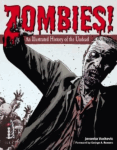Zombies! An Illustrated History of the Undead
Jovanka Vuckovic (Foreword by George A. Romero)
St. Martin’s Griffin
Trade Paper, 176 pages, $17.99
Review by Sheila M. Merritt
A beautiful book about zombies: Can you say “oxymoron?” Yet, this is precisely what Jovanka Vuckovic delivers with Zombies! An Illustrated History of the Undead. Chock full of photographs and illustrations (most in vivid color) this volume could be described as a coffee table book; depending, of course, on the company one keeps. Covering the vast and varied mediums which interpret zombie lore, Vuckovic sums up the subgenre’s rampantly pervasive appeal: “In the past decade, zombies have become a mainstay of all creative media, creeping slowly but surely into books, movies, television, video games, comics, and now, increasingly, online.” Beginning with a history containing myths; superstitions; racially manipulative machinations; and political power plays, the author delves into the origins which were the basis of a pop culture phenomenon. She weaves a stimulating study of how genre fiction transformed and embraced the walking dead.
After the historical background, a bit of early literature is addressed. Films, however, are the bulk of the book’s focus. From the silly to the stark and serious, movies have had a relationship with zombies since the early 1930s. The American Great Depression of the era created a psychological kinship with the disenfranchised lumbering dead: “With entire families in financial ruin, nearly everyone faced the grim reality of joining the defeated drones in the breadlines – robbed of their dignity and personal autonomy.”
The cinematic conceptualization of the subgenre shifted with time. “The 1950s is generally considered the worst decade for the zombie.” And given the notoriously bad Plan 9 from Outer Space, as just one example, few would challenge Vuckovic’s conclusion. It was during the 1960s that two major transitions occurred; forever altering the image of the zombie. In 1966, Hammer Films released John Gilling’s atmospheric The Plague of the Zombies: “Most notable is a spooky dream sequence in which the dead slowly rise from their graves in a cemetery – clawing at dirt in filthy robes – a motif that would later become commonplace in the zombie film.” The gold standard for all subsequent perceptions of undead behavior is, obviously, 1968’s Night of the Living Dead: “The concept of the zombie as cannibal was unheard of until this point in cinema history. From this moment on, zombies would almost always be cannibals.” George A. Romero’s groundbreaking movie gives audiences something to chew on as well; multiple metaphorical meanings to the bleak narrative.
1985 brought another prototype into play: Walking and talking corpses who have a hunger for brains. Return of the Living Dead made the entities slightly verbal, cranial craving creatures: “For the first time, the living dead could talk, hatching the now famous zombie cry for ‘Braaaaaaaaaaains!’ Finally, eating brains specifically was an entirely new twist on the living dead, one that would become a permanent feature of the zombie.”
The attraction of zombies has spread like a plague in recent years. Its permutations are a fascinating display of cultural adaptation. As times and tastes changed, the monsters morphed into the millennium with undying enthusiasm. In Zombies! An Illustrated History of the Undead, Jovanka Vuckovic infuses the titular topic with intelligence and vitality. The book is a lively reminder of how interesting the undead can be.










Great review. I think I need to pick this one up. Jovanka Vuckovic is the former editor of Rue Morgue magazine, so she definitely knows her walking dead.